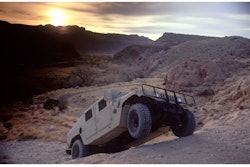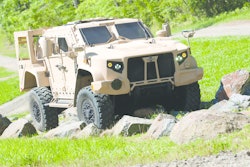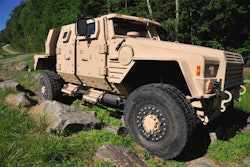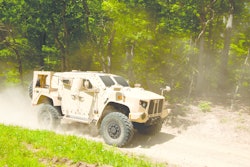Currently in the prototype testing phase, the Joint Light Tactical Vehicle (JLTV) program continues down its outlined schedule with a diligence that truly demonstrates the understanding that delays mean longer time soldiers go without the best protected mobility vehicle possible. As always, a soldier’s survivability is paramount as the programs primary objective.
The JLTV program is a joint endeavor with the United States Marine Corps and Army to fill a performance gap that was left unmet with the High Mobility Multipurpose Wheeled Vehicles (HMMWV, or humvee) after 9/11. “The humvee was the clear choice years ago when there were clearly defined battle lines,” explains Colonel John R. Cavedo Jr., Joint Project Manager, JLTV, US Army. “After September 11, there was no longer a ‘front line.’ Any place outside of the fort operating base was the front line and anyone that went outside that line could be in a fight. What we saw in Iraq and Afghanistan was the iron triangle of Payload, Performance and Protection was not balanced for the mission we were asking our soldiers in those humvees to do.”
To increase the humvee’s protection capabilities to the soldiers now operating in this ‘new war style,’ up-armored humvees were introduced, but it came at a cost to vehicle performance and payload. The vehicles were running with weight overages of 1,500 lbs. and the mobility suffered when the vehicle was not on hardtop roads.
“At that point, we introduced a stop-gap, the MRAP vehicle specifically to close the protection gap. The MRAP has a very unique mission set; it is not an expeditionary vehicle, nor does it have significant off-road capabilities or is easily transportable.
“Around 27,000 MRAPs were built by about six OEMs with over 30 variants, which is not sustainable long-term. The MRAP decision was made and the risk was taken because at the time it was only about saving lives. We knew there was going to be a problem down the road when it came to sustainment,” says Col. Cavedo.
The JLTV is designed to be a ground-up solution that is purpose-built to be a fully balanced vehicle meeting all three criteria of performance, protection and payload. “It’s going to have an enormous amount of mobility, but its primary purpose was to have protected mobility for expeditionary service.” Other key areas of importance for the vehicle’s performance include improved lethality, survivability, transportability and expeditionary capabilities; reduced operational energy requirements; configurable mission packages; increased payload and built-in network readiness.
The criteria are all tied together, for example, improved network connectivity brings all of the ISR sensor data together giving a vehicle commander real-time situational awareness and allows the vehicle to avoid potential threats, increasing its survivability. The answer to more survivability isn’t always adding more armor, and more weight, especially when the JLTV is set to be almost 60% lighter than the MRAP vehicle with the same blast resistance expectations.
Competition is healthy
The three participating OEMs competing for the Services’ single vendor contract—Oshkosh Defense, AM General and Lockheed Martin—are currently in the midst of the 14-month government testing phase with 22 prototype vehicles from each OEM (total of 66 vehicles) developed during the previous Engineering and Manufacturing Development (EMD) phase, spread across 18 different test sites.
JLTV is one of the first programs to fully implement competitive prototyping during the EMD phase. Competitive prototyping is said to reduce technical risk, validate requirements and promote adherence to cost constraints. “Does it cost more up front? Yes,” says Col. Cavedo. “Ultimately, we’re paying for two vendors’ design time and testing that will never be fully realized. But, I think in the long run, the return on investment of having that healthy competition keeps the program moving forward and will reap huge benefits downstream by getting the best product at a competitive price.”
After testing is complete, a final Request for Proposal (RFP) will be released in October and several months of source evaluations will decide the winning OEM to receive the Low Rate Initial Production (LRIP) contract award in July of 2015. There is absolutely no intention by the government to award a multiple-OEM contract, clarifies Cavedo. “The selection is by best value, not necessarily lowest cost,” he continues. The OEM that can deliver the most performance capabilities (as outlined in the JLTV Purchase Description) while effectively balancing cost and achieving an Average Unit Manufacturing Cost no greater than $250K (BY11) has the highest probability of winning the competition.
Three years of LRIP will be followed by an additional five years of full-rate production, with a total program requirement of 50,000 JLTVs for the Army and 5,500 for the Marine Corps.
Where the opportunities lie
As of right now, the government does not own the vehicle configurations. They are wholly owned by the OEMs. Once the LRIP contract is awarded to the selected OEM, the JLTV program will incentivize the OEM to continue to make the vehicle stronger, faster and more cost effective, “so opportunities to participate in the JLTV program [for system providers] will continue to exist after the contract is awarded,” Col. Cavedo says.
“We want components and systems to be able to be flexible to move across other vehicle platforms. That way a vehicle operator can move from a JLTV to an FMTV, for example, and know how to engage with the vehicle.
There is an abundance of capabilities and challenges that the JLTV must address that technology and service providers can help tackle, the most obvious of which is overall system reliability. When it comes to the safety of a soldier in a volatile environment, system failure is an unacceptable additional risk in an already dangerous situation. The same can be said for ways to decrease maintenance intervals as well as the time required to perform routine maintenance through solutions such as more reliable cabling and connections, and easier access to filters and fluids. Enhanced component wear and life of brake pads, filters, lighting and lubricants adds a layer of dependability of the vehicle to perform optimally for longer intervals.
Lightweighting of hardware and other vehicle components and armor is a key element to meet the vehicle’s increased protected mobility expectation by decreasing the overall vehicle weight. Adding heavy armor limits the JLTV’s expeditionary expectations, one of its principal purposes.
Just as any off-road equipment manufacturer can understand, the cost savings add up fast with any decrease in fuel consumption, and the military is no exception. Apart from fuel efficiency, a give focus by the Department of Energy (DOE) has been focused on improved power density and capacity of battery systems to minimize unnecessary fuel demands, allow the vehicle to operate quietly and provide off-board power to limit the need for generator haulage.
No matter what the performance metric or underlying cost savings, the fact remains that priority number one is the safety and survivability of the soldiers fighting in a brand new battle field where everywhere is a front line and everyone is susceptible to danger. All bets are off, and the JLTV program isn’t gambling with second best.
Get more information online about the three participating OEMs, their vehicles and the technologies they’re employing to differentiate themselves while meeting the challenging JLTV parameters and performance expectations. Go to www.oemoffhighway.com/10909561 to read Pulled into the combat field from the April 2013 issue of OEM Off-Highway magazine.


















![Hcm Ax Landcros Press Release[32] jpg](https://img.oemoffhighway.com/mindful/acbm/workspaces/default/uploads/2025/11/hcmaxlandcros-press-release32jpg.mAEgsolr89.jpg?ar=16%3A9&auto=format%2Ccompress&fit=crop&h=135&q=70&w=240)